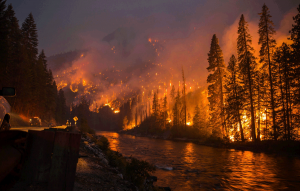Wildfires – Summer Safety and Firewise. While wildfires, forest, brush or scrub land fires happen year round the hot summer season is the peak time, especially in the West, but throughout the country.

Wildfires, Summer Safety and Firewise
The Firewise Program, a joint venture between insurance companies along with federal, state and local communities is a proactive attempt to mitigate harm and danger to lives and properties.
As population pressure continues, more people are moving second and first homes into the interface of suburban and rural areas. The hot, dry weather of summer, or of extended drought periods will dry fuels allowing for the rapid spread of fire once an ignition has begun. Fuel, in the form of dry brush, trees, especially those which have been killed by disease or insects, such as the pine bark beetle along with leaves and pine straw create a huge fire load that contributes to the spread of fire. Topography is also a contributing factor. Fires advance more rapidly up a slope than across level ground.
Defensive measures can be taken in all areas to slow or halt the spread of fire while maintaining a pleasing landscape. First, by clearing away from the house or other structure, plants that are brushing against the walls. This includes weeding out grasses or weeds that will encroach at ever opportunity. Next, use native plants. away from the structure. This will be determined by the area of the country in which one resides but some plants are never a good idea. A forester recently described juniper bushes, not the trees, as, “Imported from Asia by Satan”. They burn hot and fast and spread rapidly.
Other steps to take are somewhat obvious, keeping the roof and gutters clear of debris and duff. Metal roofs are an attractive means of helping protect property. Keeping tree limbs cut away from roofs by at least ten feet helps in this process. Further, remove all limbs at least ten feet from the ground, higher in some cases, so the flames of a possible fire will have a much harder time climbing a tree and igniting a crown fire. In the west, Douglas Fir and Ponderosa Pine are very fire resistant unless. the branches ignite.
Use proper planting practices, healthy, insect and disease free plants and trees when landscaping. Xeriscaping is not a bad means of slowing fires. Maintaining a 30 foot clear barrier, around structures is recommended, this can be rock or gravel, incorporating driveways as firebreaks is very useful. Cut grass and work at keeping out invasive, non native plants and weeds from the area. Believe me, this is very hard. Water and fertilize properly. If possible, an in ground sprinkler system in the immediate area around structures, with a generator to keep the well pump working if one is well dependent, will help defend against creeping fire. Practice good pruning of trees and shrubbery. This will remove dead or diseased branches lowering the opportunities for fire to catch easily.
For information relevant to particular states or regions refer to the local county extension agent also nationally, for guidance to individual state programs, the Insurance Institute for business and home safety will connect the reader to broader assistance. Firewise is a great program.
In Washington State, the Department of Natural Resources is useful. Washington State University has a wealth of information about all forms of plant and surface management. The Master Gardener Program in each county will be more than happy to assist in advising how and what to plant for both aesthetics and Firewise purposes.
Finally, the Firewise certification program may also help in lowering insurance costs, but this must be verified with the individual carriers.
Written by Robert Morthorst